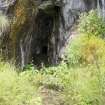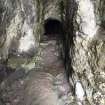Following the launch of trove.scot in February 2025 we are now planning the retiral of some of our webservices. Canmore will be switched off on 24th June 2025. Information about the closure can be found on the HES website: Retiral of HES web services | Historic Environment Scotland
Eigg, Uamh Fhraing
Battle Site (16th Century), Cave (Period Unassigned), Human Remains (16th Century)
Site Name Eigg, Uamh Fhraing
Classification Battle Site (16th Century), Cave (Period Unassigned), Human Remains (16th Century)
Alternative Name(s) Massacre Cave
Canmore ID 22183
Site Number NM48SE 20
NGR NM 47493 83471
Datum OSGB36 - NGR
Permalink http://canmore.org.uk/site/22183
- Council Highland
- Parish Small Isles
- Former Region Highland
- Former District Lochaber
- Former County Inverness-shire
NM48SE 20 4749 8352.
Uamh Fhraing, 'Frances's Cave', is 255' long and 18' to 20' high with an entrance only 3' high. The floor is strewn with human bones.
Name Book 1877
Scene of the massacre of 395 McDonalds by the McLeods in 1577.
M E M Donaldson 1920
A brass coin from the cave is in the Royal Museum of Scotland (RMS).
Proc Soc Antiq Scot 1863
A human skull discovered in this cave by a boy on holiday was handed in to Birmingham Museum in 1979. The coroner verified that the skull was of some antiquity and belonged to a child (unsexed) of 5-6 years of age.
Information from R Gourlay, Inverness Museum, 7 September 1979 (NMRS MS/974/5).
Field Visit (October 2001)
This cave is entered by a low and narrow passage which broadens out into a cavern about 70m long. This is traditionally the location of the infamous massacre of 1577, the culmination of a violent feud between the Clanranald MacDonalds and the MacLeods of Harris. Tradition relates that a force of MacLeods was sighted sailing from Skye, prompting almost the entire population of Eigg to retreat to the cave. After three days of fruitless searching the MacLeods retired, but returned after spotting a scout sent out from the cave. Following his footsteps in fresh snow, they reached the cave entrance, where they lit a huge fire, suffocating all those inside. The earliest reference to this event is to be found in a late 16th century ‘Description of the Isles of Scotland’, which claims that 395 people were killed. It seems that the bodies were never retrieved, as 200 years later the writer of the Statistical Account (Stat Acc v17, 288-9) records that about 40 skulls remained. Eventually, the parish priest removed the remaining bones for burial, though a fragment of skull was found as recently as 1979 (MS 974/5).
Visited by RCAHMS (SDB) October 2001
Dressler 1998, 14-16


























